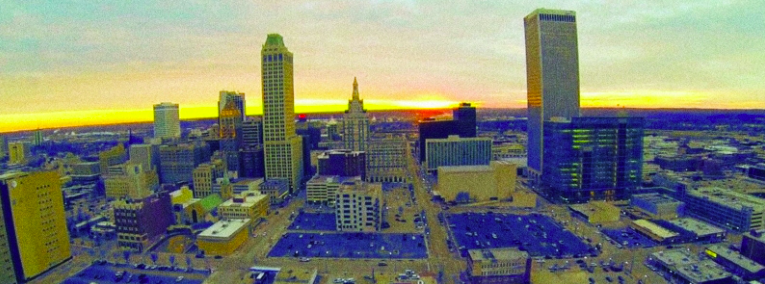Growing Pains: How thoughtful development will build an inclusive community
Last month, I reported on the Davenport Urban Lofts, a high-end condo project (units start at $450k) set for construction in 2016 on the Cain’s block. Not long after the story ran (see the Voice’s June 17 issue), OKC-based media blog The Lost Ogle picked up the story, and an independent petition against the lofts appeared on Change.org. The petition asked how Davenport residents expect to deal with the rowdiness of surrounding venues and concluded that it’d be best for everyone if Davenport found another location.
Citizen response to the loft project has run the gamut—the petition had nearly 2,300 signatures at the time of writing; baby-boomer apologists have taken aim at The Lost Ogle’s “ageist” rhetoric; commenters have rattled sabers at invading “rich” Tulsans, while others have shot back, “How the hell is money a bad thing?” Between the cannon fire in the comment forums, former Okies have brought recon from distant battlefields. One expat, a veteran of the Bay Area tech boom, wrote, “C’mon Tulsa—you can do this right—I believe in you.”
Web comments are far from academic sources, but San Francisco truly did not “do this right.” The area’s influx of tech workers (and demand for luxury condos to house them) inflated rent by 13.5 percent last year (a 1-bedroom apartment in the Mission District cost more than $3,000 per month). Despite surging costs, housing is in such short order that Bay Area homes have been selling for, on average, $62,000 above asking price. Between 1992 and 2011, the number of Bay Area businesses that closed or relocated increased by more than 880 percent.
Matt Shapiro, who grew up in Tulsa before heading West in ‘94, recently lost his longtime Mission District venue, the Elbo Room. His landlord did not renew their lease and signed the demolition papers before obtaining permits for the condos that will replace it.
“Less than 10 units,” Shapiro said, laughing. “That’s not solving the housing crisis.”
Some see Tulsa as “the next Austin,” yet a combination of condos, rising rent and outdated noise curfews has “the live music capital of the world” closing venues and festivals at a record pace.
Such scenarios might seem far-fetched for Tulsa—urban growth is what our city wants. But without progressive noise laws and zoning tools, the 2015 Condo Battle might be remembered as just the first in a long, difficult War of Petitions.
So much noise
A salient part of the Davenport question isn’t ageist or classist but an ist-less concern about noise complaints. Although the Davenport project lists “live music venues” as a neighborhood plus, future tenants have every right to complain about noise.
Our noise ordinance bans “any radio, phonograph, or any musical instrument in any manner or in such volume, particularly during the hours between 11:00 p.m. and 7:00 a.m.”
Under this law, not only the Yeti and Soundpony but The Fur Shop, Mercury Lounge, Fassler Hall, Downtown Lounge, The Colony, Vanguard, The Hunt Club and countless others have been operating illegally. Davenport isn’t Tulsa’s first luxury development near a venue, and it certainly won’t be the last.
This year, San Francisco placed a Band-Aid on its hemorrhaging entertainment districts with legislationpreventing residents from suing venues over noise. The groundbreaking law also requires developers to work with venues and neighbors to make sure tenants know the lease they’re about to sign is a noisy one. Tulsa might be years away from a Bay Area-sized sound dilemma, but it won’t be a crisis if we plan ahead.
Dist. 4 Councilor Blake Ewing said Tulsa’s archaic noise ordinance is worth revisiting. A revision to protect entertainment districts would begin with a public hearing, which Ewing plans to host some time in August.
Talking in code
Smart growth goes beyond protecting live music. Davenport’s partners modeled their design after other facades in the Brady Arts District, but detractors fear its height and overall look will be out of place. Another concern, even from proponents of the project, is that a lack of ground-level retail and services will add nothing to the district’s desired walkability and make it a missed opportunity for sales tax revenue. Despite the validity of those concerns, the proposed development is within code.
The current zoning code for the Central Business District allows a variety of property uses, many of which would clash with the existing culture and aesthetic. INCOG’s Susan Miller said changing the code wouldn’t be easy because downtown property owners, who have a say in the code, are likely to balk at shrinking uses.
Still, the City is in the process of updating its zoning code and has included the tool of Plan Based Overlays. With this tool, property owners can customize an overlay on a defined area to preserve certain neighborhood characteristics and pump the breaks on questionable developments.
The zoning code update has been a long time coming. The current proposed draft of the code update prohibits Plan Based Overlays within the Inner Dispersal Loop because, Miller said, “certain property owners did not like the idea.”
Carlos Moreno of TulsaNow, a grassroots organization for sustainable development, said leaving Plan Based Overlay out of the code is a bad idea.
“You’re going to have even more residential issues inside of the IDL, because the chamber wants to attract more residents there,” Moreno said. “Sooner or later, you’re gonna need rules.”
At upcoming public hearings over the zoning draft in September (dates to be announced), Tulsans can voice concerns about the draft directly to decision makers before City Council holds its own public hearings and takes a final vote.
Amanda DeCort, executive director at Tulsa Foundation for Architecture, suggested residents make these meetings a priority.
“When it comes to this zoning code update,” she said, “every Tulsan needs to be awake.”
Urban removal
Increasing property values (and subsequent rent increases) are the zinger hidden in these development questions. When artists are priced out of their communities, they go to new districts. Following them are trendy restaurants, rising property values and eventually high-end developments—also known as gentrification. This is not Tulsa’s first big brush with gentrification—the north side of our city is a product of it.
Since the race massacre of 1921, the Greenwood District has seen more downs than ups. With Greenwood smoldering and its surviving black citizens in camps (unable to leave unless a white person came and claimed them as an employee), The Tulsa Real Estate Exchange worked to move Greenwood north. Headed by Tate Brady, Klansman and namesake of the Brady Arts District, The Exchange proposed a fire code designed to make rebuilding cost-prohibitive for Greenwood residents. The Exchange also aimed to turn Black Wall Street into an industrial zone for white business.
Working from a tent amidst Greenwood’s rubble, B.C. Franklin fought and overturned the code. But the message to black Tulsans was clear—white Tulsans tried to steal their district after destroying it and then provided no help in rebuilding. Even the name “Tulsa Race Riot” was a scheme. Used to deny black citizens the chance to file insurance claims, the name insinuated they had merely set fire to their own property. A few remained and rebuilt Greenwood, creating a midwestern Mecca for jazz and blues. Those who didn’t leave the state entirely headed to rural communities or just went north.
Urban renewal, or “urban removal,” ran I-244 directly through the heart of what was once Black Wall Street, and several attempts at a spot on the National Historic Registry failed. Greenwood residents themselves contested one such bid when they discovered the State Historic Preservation Office had labeled the area “The Tulsa Race Riot District” and drastically shrunk its historic boundaries. As Greenwood withered to less than a block in the absence of protections, the Brady Arts District built atop two blocks of the former community.
‘Gentrification with justice’
In addition to encroaching upon Greenwood, downtown development trends are likely to send a flood of new faces to Kendall Whittier, an area that is nearly 50 percent Latino. Though Kendall Whittier welcomes growth, area leaders are wary of gentrification and are working deliberately to stem the tide.
Kendall Whittier Main Street Director Ed Sharrer says Kendall Wittier is experiencing a rebirth thanks in part to Circle Cinema and downtown Tulsa’s recent success. But business gentrification is a constant concern, he said. Sharrer mediates between property owners and prospective tenants to attract development that fit in the district. He strives for neighborhood synergy—a vision that might mean just one “good bar” for the main square. Sharrer said he and Kendall Whittier Main Street property owners envision a neighborhood where Tulsans can get dinner at Calaveras, catch a movie at Circle Cinema and finish their night with a drink.
“We don’t want to become a little drunk Disneyland,” he said.
Based on the philosophy of gentrification with justice, Growing Together—a partnership supported by the Community Action Project of Tulsa County—focuses on education, mixed income housing and community vibrancy in the Kendall Whittier area. Growing Together’s Kirk Wester said area leaders are aware of downtown’s growth and are prepared for an influx of people seeking more affordable housing.
“We’re ahead of the game,” Wester said, citing 230 empty lots as a buffer between them and the impending housing crunch.
Wester said Growing Together seeks to attract more developments—and the right kind of developments. The organization is also working with the developers for “control of the future,” which means they intend to secure First Right of Refusal clauses with developments in the neighborhood. This would allow Growing Together to buy back properties and have a hand in the area’s property values.
There’s a clear connection between Tulsans’ recent conversations about the Turkey Mountain outlet mall, the Gathering Place sidewalk and the Davenport project. They each point to the reality that without intelligent planning, we risk squandering the finite land available to our city, and worse—further marginalizing fellow citizens. If we want to move beyond our petition-prone state of feverish reactivity, some challenging and forward-thinking conversations need to take place now.



